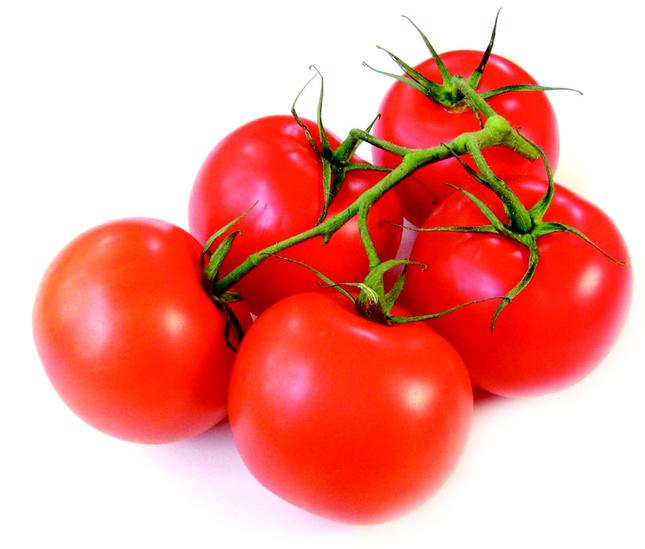Lewis Grizzard, American writer and humorist, said “It’s difficult to think anything but pleasant thoughts while eating a homegrown tomato,” and considering all the well-loved recipes which include them, one would be hard pressed not to agree. Often cooks think of tomatoes as an item to be served on the side or as an ingredient in a more complex dish, but with such beautifully plump and juicy tomatoes in season, why not serve them up as the entrée?
“Tomatoes are something to celebrate right now because they are here,” says Chef Ris Lacoste. “We wait for tomatoes and they always come mid-July. Finally they’ve arrived at the farmers markets. In celebrating the tomatoes, this is the time to serve them.”
Though when we think of tomatoes our thoughts typically go to a round, red fruit, there are actually countless varieties to choose from.
And just like with apples, it may become difficult to decide which breed you need. Green varieties are acidic so we use them in treats like Fried Green Tomatoes. Green tomatoes should be picked when they are under-ripe but still firm in order to cook them, otherwise they will shrivel up. However, green tomatoes are not to be confused with Green Zebras, which are fully ripe and just happen to be green. Green
Zebras almost have the tartness of an apple and their acidity allows them to go well with seafood.
A small variety, the Cherry tomato, is wonderfully versatile because there are so many different colors and tastes within this category. Cherry tomatoes have a sweetness that blends well in salads, while yellow cherry tomatoes have a lower acidity, giving them a softer, blander flavor which pairs with other fresh veggies very well.
No matter what variety you care to try, Ris suggests looking for Heirloom tomatoes. In recent years, big companies have taken a large market share of the tomato production. Most tomatoes are now mass produced and the seeds have been engineered. Hormonally engineered tomatoes make for larger more beautiful tomatoes and are readily available at any chain grocer, however they aren’t as tasty.
Heirloom tomatoes are natural and have valued flavors and colors, and are grown specifically for those characteristics.
But how do you know which variety you want and which ones are heirlooms? Ask your local grower. If you ask a grower at your local farmers market for a recommendation, they can usually point out which breeds are sweeter, or will hold up during baking, or which will breakdown for sauces, etc.
“The farmers will know about their tomatoes. They’re their babies,” says Ris.
The farmers also understand tomatoes are one of Mother Nature’s greatest phenomenons. Tomatoes are very sensitive to the weather, much more so than other types of produce. During seasons with a lot of rain, tomatoes tend to be soft, while during dry seasons, the tomatoes tough-skinned to lock in moister.
Once you’ve made your perfect tomato selection and you have them in hand, you need some ideas about what to do with them. Chef Ris has shown herself to be a culinary master, and she understands that cooking is a learning process and you have to do your research.
“I love classic recipes and I don’t want to mess with them. So I’ll research as many versions as I can. I look in books and see how they relate and what the different versions are just to get a good understanding of a dish that’s been around for the ages,” says Ris. “Sometimes I give my own special twist and hope it will be a Picasso, but I try to really hold true to the classic dishes.”
While it’s fun to put your own spin on a recipe, like Chef says, don’t neglect the classics. There are many tomato-y summer dishes you just can’t go wrong with.
“BLTs in the summer. I want thick cut tomato, white toast, mayonnaise bacon and lettuce. That’s just heaven. Go make a BLT right now,” says Ris.
Everything you need for Ratatouille: eggplant, summer squash, onions and, of course, juicy tomatoes are fresh on the shelves now. Try this dish as an elegant side to your Sunday omelet. Throw some tomatoes in the blender for a fresh Bloody Mary, and garnish with summer green beans. Make your own Panzanean salad with thick tomato cuts, cucumber, and feta or mozzarella cheese. Try Ris’ own perfected gazpacho recipe. The possibilities are endless.
And if you’re not in the mood to prepare one of Chef Ris’ recipes tonight, save it for tomorrow, but go cut yourself a thick slice. Sprinkle on a little salt and pepper and enjoy it right now, because now is the time for tomatoes.
Blue Goat Cheese Panzanella Salad
3 stalks celery, sliced
½ head radicchio, cut into roughly 1” squares
2 cups baby spinach, cleaned and dried
½ head romaine, cut into roughly 1” squares
6 radishes, sliced
48 cherry tomatoes, cut in ½, any or mixed colors
1 small red onion, cut into julienne
1 loaf raisin walnut bread, cut into ½” cubes for croutons
9 oz blue goat cheese, cut into ½” cubes
For the dressing:
Makes 5 cups, much more than you need
2 shallots, diced
4 cloves garlic, minced
zest and juice of two oranges
2 Tablespoons fresh chopped oregano
2 Tablespoons fresh chopped basil
1 Tablespoon Dijon mustard
½ cup Kalamata olive brine
½ cup balsamic vinegar
½ cup red wine vinegar
1 cup walnut oil
1 cup extra virgin olive oil
1 cup peanut oil
salt
freshly cracked black pepper
For the port glaze:
16 oz port
8 oz balsamic vinegar
To make the glaze, combine the port and balsamic vinegar in a heavy based non reactive pan and reduce to a thick syrup. The 3 cups of liquid should reduce to about 4 ounces. Let cool and keep covered in the refrigerator for as long as a month.
To make the vinaigrette, combine all of the ingredients except the oils in a bowl. Slowly whisk in the oils one at a time starting with the walnut oil followed by the olive oil and then the peanut oil. Vinegars and oils vary in strength and flavor. Each dressing is different. You may therefore not need to add all of the oil in this recipe.
Be sure to taste the vinaigrette before adding the last of the oil to check for desired level of acidity. Taste for seasoning and adjust. The vinaigrette can be made and kept covered in the refrigerator for up to a month. However, it is best served at room temperature.
Toss 1 ½ cups of the raisin walnut croutons in olive oil and toast in a 350 degree oven until golden.
To make the salad, combine all of the ingredients in a bowl, including the croutons but not the cheese. Season with salt and freshly cracked black pepper. Dress to your liking with the olive vinaigrette and divide the mix into 6 bowls. Stud each salad with about 1 ½ ounces of the blue goat cheese and drizzle with the port glaze. Delicious.




